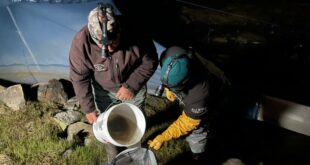Close-knit industry using microchips to protect renowned product from pretenders

In a towering warehouse on the flat, fertile outskirts of Modena, in northern Italy, hefty golden wheels of cheese sit stacked in columns that soar to the ceiling.
This cathedral-like space is where the more than 40,000 wheels of Parmesan made yearly by the producer Quattro Madonne come to ripen — and where they are judged worthy of carrying the hallowed name of Parmigiano Reggiano.
"You can hear this one sounds different," said Alberto Pecorari of the Parmigiano Reggiano Consortium, after he taps a small metal hammer against one wheel of cheese, producing a wooden, knocking sound — then against another, which makes dull thuds.
"This one is convex," he said of the second. "There's an air bubble inside. It doesn't pass the test."
The slightly swollen wheel of cheese, he says, will have the name "Parmigiano Reggiano" machine-scraped off its rind and sent off to be sold in a mixed package of generic grated cheese.
The tapping test is just one example of how the Consorzio Parmigiano Reggiano — founded in 1934 to defend the cheese's 1,000-year-old tradition and guarantee the standard and production of Parmesan — takes its raison d'être extremely seriously.

Golden wheels of cheese stacked to the ceiling as they ripen
Wheels of Parmesan are ripened for an average of 24 months in temperature-controlled warehouses. The cheeses take on a darker hue as they age, some reaching 50 months. Each is tested with a metal hammer to ensure quality.
Parmesan producers go high-tech to fight imitators
While still fresh and malleable, each wheel of the cheese is encased in a braille-like plastic that presses the Parmigiano Reggiano name into the circumference, with the date and place of "birth" of the wheel. For the past two decades, a QR code made of milk proteins has also been embedded in the rind.
Yet Parmesan producers say these identifying markers are insufficient in the ongoing struggle to counter what data shows is a $2.5 billion Cdn annual business of low-quality ripoffs — almost equal to the yearly global sales of real Parmesan.
To that end, the consortium is now testing a new way to fight fakes, with a digital microchip the size of a grain of salt that can be read with a laser to track and trace the wheels.
"The goal of the micro-transponder is to register in real time when and where the Parmesan is produced," Pecorari said, holding up a translucent label with a QR code, the tiny chip inside emitting a glint of reflected light.
The chips have been inserted into the rinds of 120,000 wheels — a small percentage of the four million made each year.
Producers say they have so far proved effective and safe, with tests in acid bath simulations of the human stomach showing they don't leak toxic materials.
While a microchip implanted in cheese may seem over the top, producers argue the care and tradition that go into making Parmesan — delicious and costly — justify the digital experiment.

Parmesan has Protected Designation of Origin or PDO — European Union status for foods that are "produced, processed and prepared in a given geographical area using recognized know-how."
The PDO rules dictate it can only be made in the small area of northern Italy near the towns of Parma, Modena, Reggio Emilia and Bologna and that the cheese must be aged for at least 12 months and tested two years after production.
Techniques have stood the test of time
The production techniques date back to the Middle Ages, perfected by Benedictine and Cistercian monks as a way to preserve the cheese for trade throughout Europe. Today, production supports some 50,000 people in the region, the consortium says.
While many are small, family operations, workers at the larger production facilities like Quattro Madonne include recent immigrants from Africa and India. About a dozen people work in production at the company near Modena.
"The first time I tasted it, I didn't like it at all," said Elijiah Doahen, who dips an expert finger into a coagulating vat of milk delivered just hours before from a special breed of local cows. "But after eating it so often, it's now my favourite."
Doahen, who arrived in Italy from Ghana six years ago and has been at the Parmesan factory for three years, says his hope is to climb the ranks and become a cheese master, a process that can take years.

The ancient art of making perfect Parmesan
Elijah Doahen, who carries out centuries-old techniques in making Parmesan at producer Quattro Madonne in northern Italy, cuts the freshly formed cheese in two, ready to be lifted in linen cloth and drained.
Once the cheese forms on the bottom of the vat, workers wrap it in a linen cloth, slice it in two and hoist in onto a bar, which then lifts and drains it. The cheese then gets pressed into round moulds and submerged in tanks of saline water for 20 days. The salt slowly penetrates the cheese while simultaneously drawing moisture from it, resulting in five per cent shrinkage.
The final step involves moving the wheels to the temperature-controlled warehouse, where they ripen for an average of 24 months — though some for as many as 50 months. It takes a year of aging for the salt to spread evenly throughout the cheese, acting as a natural preservative. (There are only three ingredients in Parmesan: milk, rennet and salt.)
'Not all Parm is created equal'
While the microchip is the latest tool being tested to guarantee people are eating the real deal, the larger battle for Italian producers is a political one: to gain control of the Parmesan name.
"Today you can use the name Parmesan for cheeses produced in Canada and the U.S.A. It is not now protected as it is in the European Union," Pecorari said. "So our main problem is that Italian-sounding names are still used, so the consumer associates this product with ours."
Julie Rusciolelli, president of Toronto-based Maverick Public Relations, which represents the Parmigiano Reggiano Consortium in Canada, says a lot of what her company does is food education.
"We're trying to tell Canadians that the stuff that comes out of the shaker bottle isn't authentic," she said, "to dispel a lot of myths, that not all Parm is created equal."
While the Parmigiano Reggiano Consortium has made little progress in stopping other cheese producers from calling their product Parmesan, sales of the real stuff have risen steadily in Canada — the result of a good distribution network and increased interest in quality products across the board, Rusciolelli says.
"We have an educated market, access to good food and are asking more questions," she said.
ABOUT THE AUTHOR

Rome correspondent
Megan Williams has been covering all things Italian, from politics and the Vatican, to food and culture, to the plight of migrants in the Mediterranean, for more than two decades. Based in Rome, Megan has also told stories from other parts of Europe and the world and won many international prizes for her reporting, including a James Beard Award. Her radio documentaries can be heard on Ideas and The Current. Megan is also a regular guest host on CBC national radio shows.
*****
Credit belongs to : www.cbc.ca
 MaharlikaNews | Canada Leading Online Filipino Newspaper Portal The No. 1 most engaged information website for Filipino – Canadian in Canada. MaharlikaNews.com received almost a quarter a million visitors in 2020.
MaharlikaNews | Canada Leading Online Filipino Newspaper Portal The No. 1 most engaged information website for Filipino – Canadian in Canada. MaharlikaNews.com received almost a quarter a million visitors in 2020.







